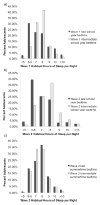The effects of bedtime and sleep duration on academic and emotional outcomes in a nationally representative sample of adolescents
- PMID: 24225447
- PMCID: PMC3943967
- DOI: 10.1016/j.jadohealth.2013.09.004
The effects of bedtime and sleep duration on academic and emotional outcomes in a nationally representative sample of adolescents
Abstract
Purpose: The overall aim of this study was to clarify and better characterize the sleep/circadian patterns of adolescents in a nationally representative sample.
Methods: We used three waves of data from the National Longitudinal Study of Adolescent Health to assess sleep/circadian patterns of 2,700 adolescents in grades seven through 12.
Results: Late school year bedtime was associated with shorter total sleep time cross-sectionally, whereas late summertime bedtime was not. Moreover, late school year bedtime was not associated with late summertime bedtime cross-sectionally. Late school year bedtime in Wave I (1994-1995) was associated with worse educational outcomes and emotional distress 6-8 years later. In addition, late summertime bedtime in Wave II (1996) was associated with more emotional distress at Wave III (2001-2002). Short total sleep time was not associated longitudinally with changes in emotional and academic functioning. Across Waves I and II, more than three quarters of adolescents who went to sleep at 11:15 a.m. or later during the school year or 1:30 a.m. or later during the summer reported sleeping fewer than the recommended 9 hours.
Conclusions: These findings underscore the significance of evaluating and monitoring bedtime in adolescents and the importance of intervention strategies that target bedtimes in an effort to reduce associated functional impairments, and improve academic and emotional outcomes.
Keywords: Academic outcomes; Adolescents; Emotional outcomes; Eveningness; Sleep.
Copyright © 2014 Society for Adolescent Health and Medicine. Published by Elsevier Inc. All rights reserved.
Figures
References
-
- Carskadon MA, Mindell J, Drake C, MA Contemporary sleep patterns of adolescents in the USA: results of the 2006 National Sleep Foundation Sleep in America poll. J Sleep Res. 2006;5(Suppl 1):1–93.
-
- Calamaro CJ, Mason TB, Ratcliffe SJ. Adolescents living the 24/7 lifestyle: effects of caffeine and technology on sleep duration and daytime functioning. Pediatrics. 2009;123:1005–10. - PubMed
-
- Dinges DF, Pack F, Williams S, et al. Cumulative sleepiness, mood disturbance, and psychomotor vigilance performance decrements during a week of sleep restricted to 4–5 hours per night. Sleep. 1997;20:267–77. - PubMed
-
- Drummond SP, Brown GG, Gillin JC, Stricker JL, Wong EC, Buxton RB. Altered brain response to verbal learning following sleep deprivation. Nature. 2000;403:655–7. - PubMed
-
- Link SC, Ancoli-Israel S. Sleep and the teenager. Sleep Res. 1995;24:184.
Publication types
MeSH terms
Grants and funding
LinkOut - more resources
Full Text Sources
Other Literature Sources
Medical


